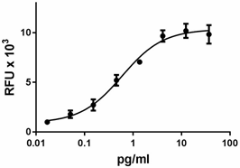- Regulatory Status
- RUO
- Other Names
- Small Inducible Cytokine Subfamily B (Cys-X-Cys), Member 10 (SCYB10), INP10, C-X-C Motif Chemokine Ligand 10, 10 kD Interferon Gamma-Induced Protein

-

Rata CXCL10 chemoattracts BaF3-hCXCR3 transfectants in a dose dependent manner. -

Rat CXCL10 chemoattracts BaF3-hCXCR3 transfectants.
| Cat # | Size | Price | Quantity Check Availability | ||
|---|---|---|---|---|---|
| 770901 | 5 µg | $83.00 | |||
| 770904 | 25 µg | $218.00 | |||
This product is not available for shipping outside of the United States.
Select size of product is eligible for a 40% discount! Promotion valid until December 31, 2024. Exclusions apply. To view full promotion terms and conditions or to contact your local BioLegend representative to receive a quote, visit our webpage.
CXCL10 is an ELR-negative chemokine structurally and functionally related to CXCL9 and CXCL11. CXCL10, CXCL9, and CXCL11 are produced and secreted by monocytes, macrophages, fibroblasts, and epithelial cells upon stimulation with proinflammatory cytokines, especially IFNγ. CXCL10 chemoattracts CD4, CD8, NK, and NKT cells through the binding to its receptor CXCR3, which is shared with CXCL9 and CXCL11. In addition, CXCL10 inhibits neovascularization in tumors and in wound healing in vivo. Also, CXCL10 has anti-proliferative effects on endothelial cells in vitro, and angiostatic and antitumor effects in vivo. It has been suggested that the anti-proliferative effect of CXCL10 in endothelial cells is CXCR3-independent and that it is mediated through GAG interaction. CXCL10 also possesses antimicrobial activity against E. coli and L. monocytogenes, and both the spore and bacillus forms of B. anthracis. CXCL10 expression is strongly upregulated in many human inflammatory diseases, including rheumatoid arthritis, type I diabetes, multiple sclerosis, atherosclerosis, allograft rejection, and others.
Product Details
- Source
- Rat CXCL10 amino acids (Ile18 – Pro98) (Accession # NP_620789) was expressed in E.coli.
- Molecular Mass
- The 77 amino acid recombinant protein has a predicted molecular mass of approximately 8.67 kD. The predicted N-terminal amino acid is Ile.
- Purity
- >98% by SDS-PAGE gel and HPLC analyses.
- Formulation
- Lyophilized from 0.22 µm filtered protein solution in PBS, pH 7.2.
- Endotoxin Level
- Less than 0.1 EU per µg cytokine as determined by the LAL method.
- Storage & Handling
- Unopened vial can be stored at -20°C or -70°C. For maximum results, quick spin vial prior to opening. Reconstitute PBS to a concentration of 0.1 - 1.0 mg/ml. Do not vortex. It is recommended to further dilute in a buffer containing a carrier protein such as 0.1% BSA and store working aliquots at -20°C to -80°C. Avoid repeated freeze/thaw cycles.
- Activity
- Bioactivity was measured by its property to chemoattract BaF3-hCXCR3 transfectants in a dose dependent manner. The relative fluorescent units were obtained using Deep Blue Cell Viability™ Kit (Cat. No. 424701). The ED50 = 0.25 to 1.5 pg/ml.
- Application
-
Bioassay
Antigen Details
- Structure
- Chemokine
- Distribution
-
Interferon gamma-stimulated keratinocytes, monocytes, macrophages, fibroblasts, endothelial, T cells
- Function
- CXCL10 chemoattracts CD4, Th1, CD8, NK, and NKT cells. CXCL10 is induced by inflammatory cytokines, and NH2-terminal cleavage of CXCL10 by DPP-IV/CD26 impairs its chemoattracting capacity and CXCR3 signaling.
- Interaction
- Activated T cells, Th1 cells, regulatory T cells, NK cells, NKT cells, endothelial cells, fibroblasts, and endothelial cells
- Ligand/Receptor
- CXCR3
- Bioactivity
- Rata CXCL10 chemoattracts BaF3-hCXCR3 transfectants.
- Biology Area
- Cell Biology, Immunology, Innate Immunity, Neuroinflammation, Neuroscience
- Molecular Family
- Cytokines/Chemokines
- Antigen References
-
1. Luster AD, et al. 1985. Nature 315:672.
2. Loos T, et al. 2008. Blood 112:2648.
3. Crawford MA, et al. 2009. Infect. Immun. 77:1664.
4. Campanella GS, et al. 2010. PLoS One 5:e12700.
5. Hoerning A. 2011. Eur. J. Immunol. 41:2291. - Gene ID
- 245920 View all products for this Gene ID
- UniProt
- View information about CXCL10 on UniProt.org
